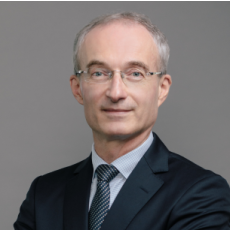TÜV SÜD is a global technical service provider specializing in testing, inspection, certification, and advisory services to ensure safety, quality, and regulatory compliance across various industries, including medical devices, automotive, energy, and infrastructure.
How significant is the life sciences sector within TÜV SÜD?
Life sciences activities at TÜV SÜD focus on ensuring that medical devices, of course, meet increasing regulatory requirements and are developed to be safe, high-performing, cyber-secure and sustainable, enabling the fastest possible market entry . This sector is experiencing rapid growth, largely due to global pressures on healthcare systems driven by megatrends such as aging populations, urbanization, and the increasing demand for accessible, high-quality healthcare.
Our role in this sector aligns with our historical mission dating back to the Industrial Revolution when we were already helping to make progress possible by protecting people, the environment and assets from technology related risks. Today, high-tech advancements extend beyond traditional engineering to include software-based and connected products, integrated infrastructure, and faster innovation cycles. While our work has evolved, the core purpose remains the same: being impartial and ensuring that technology works safely and is also interoperable, cyber-secure, privacy-compliant, and sustainable. Our efforts contribute to improving global access to high-quality medical devices and therapies, ultimately shaping healthier societies.
TÜV SÜD has reportedly helped life sciences companies reduce losses by approximately 23 billion dollars since 2002…
Life sciences companies operate in an increasingly complex regulatory landscape, particularly in major markets like the U.S. and Europe, which are working to harmonize regulations to facilitate smoother market entry. At the same time, emerging economies such as China, Saudi Arabia, and Malaysia are developing their own sizable healthcare systems, introducing additional regulatory challenges. Technological advancements, including software-defined products, connected devices, and sustainability requirements, further complicate compliance.
We add value in several ways as an independent third party. First, and help manufacturers navigate regulatory hurdles efficiently, reducing redundancies in testing and certification to accelerate time to market. Second, we assist in identifying potential regulatory blind spots early, preventing costly redesigns and recertifications. Lastly, we offer testing services during development to ensure biocompatibility, cybersecurity, and functional safety before final certification. Additionally, our involvement in global standardization committees allows us to shape regulations and provide manufacturers with foresight on upcoming compliance requirements, helping them avoid unforeseen risks.
Is there a trend toward regulatory harmonization in the medical device industry, or are we seeing divergence?
The reality is a mix of both. There is a clear effort to harmonize regulations, as it benefits both businesses and healthcare systems by streamlining product approvals and ensuring quicker access to innovative technologies. Programs like the Medical Device Single Audit Program (MDSAP), accepted in the U.S., EU, and Australia, allow a single audit to be recognized across multiple jurisdictions. There is also a voluntary association of medical device regulators working toward further alignment.
However, challenges remain. Some countries, particularly emerging markets, impose additional local requirements, such as mandatory clinical trials and specific conformity assessments. The pace of technological change also complicates regulatory adaptation. Regulators must strike a delicate balance between fostering innovation and ensuring safety, requiring them to embrace standardization while adapting to rapid developments in AI, sensors, and software-based products.
Given the fast pace of innovation in AI, how does TÜV SÜD stay ahead in understanding new technologies and their regulatory implications?
Staying ahead requires a multi-faceted approach. First, we leverage our global presence and expertise across various industries, allowing us to understand AI and emerging technologies from multiple perspectives. AI, for example, is not only transforming medical devices but is also embedded in machinery, consumer products, and industrial automation. This broad exposure enables us to assess AI-driven medical products more effectively.
Additionally, technological convergence is bringing together fields like materials science, software, and cybersecurity within medical devices. For example, advanced materials in implants introduce new risks, such as unexpected reactions under MRI conditions. To address these complexities, we maintain a highly qualified global team capable of evaluating the safety, performance, and compliance of cutting-edge medical devices.
Furthermore, our active role in regulatory committees allows us to influence evolving frameworks. The EU has incorporated AI considerations into medical device regulations, while the FDA provides evolving guidelines. By engaging in these discussions, we help shape adaptive, forward-looking regulations and guide manufacturers through a fast-changing compliance landscape.
How do regulatory differences related to AI, impact your work across jurisdictions?
Regulatory approaches to AI differ significantly. The EU has taken a stringent stance with its AI Act, introducing robust requirements to ensure safety and fairness. In contrast, the FDA has opted for guidance-based regulation, which is less rigid but still provides direction on AI implementation in medical devices. This divergence creates both challenges and opportunities.
For companies operating across multiple jurisdictions, these differences require careful navigation. In the EU, for instance, AI used in medical devices must meet strict performance, transparency, and safety standards. In the U.S., manufacturers have more flexibility but must align with evolving FDA guidance. Our role is to help companies anticipate and manage these regulatory nuances, ensuring compliance without unnecessary delays. By mapping regulatory trends globally, we provide insights that help manufacturers chart efficient pathways to market.
How do you see the medical device industry evolving in the next three years?
While predicting the future is difficult, the trajectory is clear. Digitization will continue to transform medical devices, making them more connected, data-driven, and integrated into healthcare ecosystems. Wearable devices, for example, are no longer just consumer products but are evolving into regulated medical technologies capable of real-time health monitoring and AI-assisted diagnostics. This shift will enhance patient outcomes but also introduce new challenges related to cybersecurity, privacy, and regulatory oversight.
Sustainability will also become a key focus, with regulators demanding quantifiable carbon footprints and greater product recyclability. Additionally, AI and software-driven updates will require ongoing regulatory adaptations to ensure interoperability and safety over time. From our perspective, technology will also enhance our own processes, allowing for more efficient risk assessments, faster documentation reviews, and better decision-making in complex regulatory environments. Ultimately, TÜV SÜD will continue playing a critical role in enabling safe, innovative medical technologies while helping companies navigate an increasingly intricate compliance landscape.




